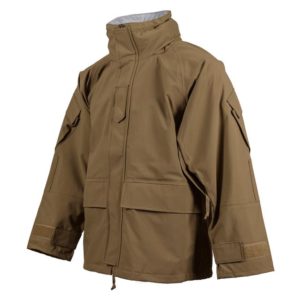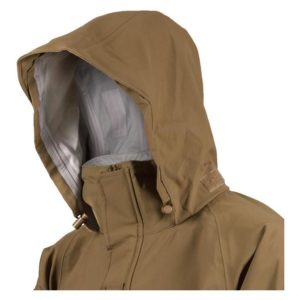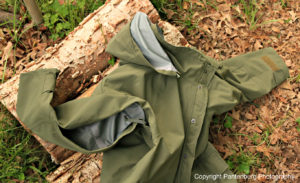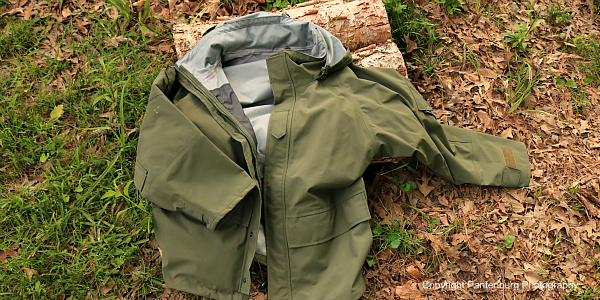Spend any time outdoors, and you’re bound to run into rain and cold weather.
And your comfort and safety will depend on your clothing. Call it your first line of defense against hypothermia. This outercoat may prove to be a survival necessity.
by Leon Pantenburg
Disclaimer: Tru-Spec supplied the product for this review. At the time of publication, there was no promotional relationship between Tru-Spec and Survivalcommonsense. Tru-Spec had no input in this review, and all we ever promise on any review is a fair shake.
Outdoors types appreciate solid rainwear. Especially when you’re far from the trailhead and the skies open up.
I just expect to get wet. There is not enough room here to tells all my outdoors-in-the-rain stories. (But I must add – I got rained on in Death Valley!) Suffice it to say, I always carry a raincoat or poncho.
I have several raincoats and ponchos and am always on the lookout for a better one. So I was interested in the Tru-Spec H20 Proof Gen 2 ECWCS Parka. It appeared to have most of the features I look for in a foul weather coat.

The Tru-Spec H20 Proof Gen 2 ECWCS Parks comes in several different colors.
Here are the specs and features of the TRU-SPEC H2O Proof Gen 2 ECWCS Parka, according to the company website.
- 3-layer nylon is windproof, waterproof and breathable
- Dintex inner lining is waterproof and breathable
- Bemis seam tapes block water from leaking in at the seams
- Hood can be adjusted with a draw cord, rolled up and stored in collar
- Upper arms have sleeve pockets which support sew-on patches
- Chest has concealed map pocket
- Stand up zip through collar
- Two-way non-freezing zipper with double storm flap
- Elbows are reinforced with nylon
- Underarms have zippered openings to allow for ventilation
- Drawstring waist comes with a cord lock
- Front placket has an insignia/badge loop field
- Sleeve cuffs can be adjusted
I decided to field test the H20 coat on a five-day Mississippi River trip with Quapaw Canoe Company out of Clarksdale, MS. My experience on my 1980 end-to-end canoe trip on the Mississippi proved that it is really hard to get wetter than during a windy, driving rain on the big river.
We didn’t get rain while paddling, but I walked several miles in the rain, several different times, when I got back. The coat performed as expected, and was very comfortable.

The hood provides protection and warmth.
Here is what I found out about the H2O parka:
Durability: A cheap coat will wear out under constant use and eventually leak. This coat is mil-spec, and appears to be sturdy and well-constructed. It has nylon-reinforced elbows and pockets for stowing essential tools, and it should last a long time under adverse conditions. We’ll see – hunting season this fall will provide a true test!
Ventilation: A raincoat with improper ventilation will soon feel like you’re wearing a plastic bag. It is easy to adjust the fit of the hood, waist and sleeve cuffs for an additional barrier from wind and rain, and also easy to open them up for added air flow.
The pit zips on the H20 coat work very well. I didn’t paddle in the rain (When you’d welcome some rain to test a product, Murphy always steps in!) But I did wear the coat while paddling, and the open pit zips worked well.
Fastenings: The zippers are made by YKK and they are sturdy. Even after I put sand in them, and rinsed it out, the zippers still functioned well.
Another important aspect is the double storm flap on front, which is a snaps and zipper combination. In freezing rain and snow, it is possible for a zipper to freeze open or shut. Closing the coat is important to warding off hypothermia! You might not be able to use the zipper, but you should be able to close the snaps. This could end up being a big deal.
The company claims the YKK zippers won’t freeze. I couldn’t check that out, but if this is true, the zippers could directly affect your survival in cold climates!
Hood: The hood is generous and covers the head well. Water drains away from your face.
I usually wear a fedora-style wool hat in all but the worst rain, and it is nice that the hood rolls up and can be stored in the stand up collar. The collar is also tall enough to keep water from draining into the coat. I also have this theory that the warm air escaping from the top of the collar, like a chimney, can be caught by the hat brim. This is one reason, IMO, that my ears feel like they stay warmer when I’m wearing a fedora or full-on cowboy hat during cold weather.
Seams: A pox on any manufacturer who cuts corners when it comes to sealing the seams on a tent or raincoat! The first place, and generally most uncomfortable place for a leak to start is at one of the seams. The H20 has Bemis seam tapes prevent water from leaking in at the seams.
Breathability: I don’t think there is such a thing as a breathable raincoat material. It comes down to air pressure. If it is raining, the air pressure outside the coat is greater than inside. If you are working hard, you perspire. The water vapor generated from sweating can’t escape through the breathable material in heavy rain.

The generous pit zips provide ventilation and help keep the wearer from getting wet inside the coat.
I came to this conclusion after years of buying and discarding raincoats. But on this subject, I defer to an outdoor wear expert, my old college roomate, Bob Patterson of Mankato, MN. Bob retired after a career as a firefighter/EMT/first responder in Minnesota. He was outdoors during the worst weather conditions, year round, for some 30 years. Here’s his take on breathable materials:
“I still have at least 50 jackets, parkas etc., and have owned many more, made of about every kind of waterproof/breathable material on the market.
“If you are going to use the coat for doing any work in the rain, get one with ventilation. There is no waterproof/breathable material that will transport perspiration fast enough to keep you dry on the inside if you’re putting out any kind of effort. It doesn’t take much effort – cutting fire wood, walking with a pack, walking without a pack, pitching tents – to work up a sweat.
“I prefer pit zips, but they also make side zips, pocket vents, back vents, and host of others. The bottom line is: to remain comfortable and dry, you have to get the moisture out, and material alone won’t do it adequately.”
Pockets: The H20 has nylon-reinforced elbows and pockets for stowing essential tools. The pockets are generous and well placed. That makes them handy.
Other stuff: If you’re operating in cold conditions, this jacket is also compatible with TRU-SPEC’s zip-in Polar Fleece (not included).
Do you need an H2O parka?
Well, it you’re outdoors regularly, you will need some form of raingear. Depending on where you go or recreate will determine how good that gear needs to be.
I think the H2O parka is a solid product, well able to protect the wearer in bad weather. It is a piece of survival/emergency gear well worth looking at.
Please click here to check out and subscribe to the SurvivalCommonSense.com YouTube channel – thanks!


Leave a Reply